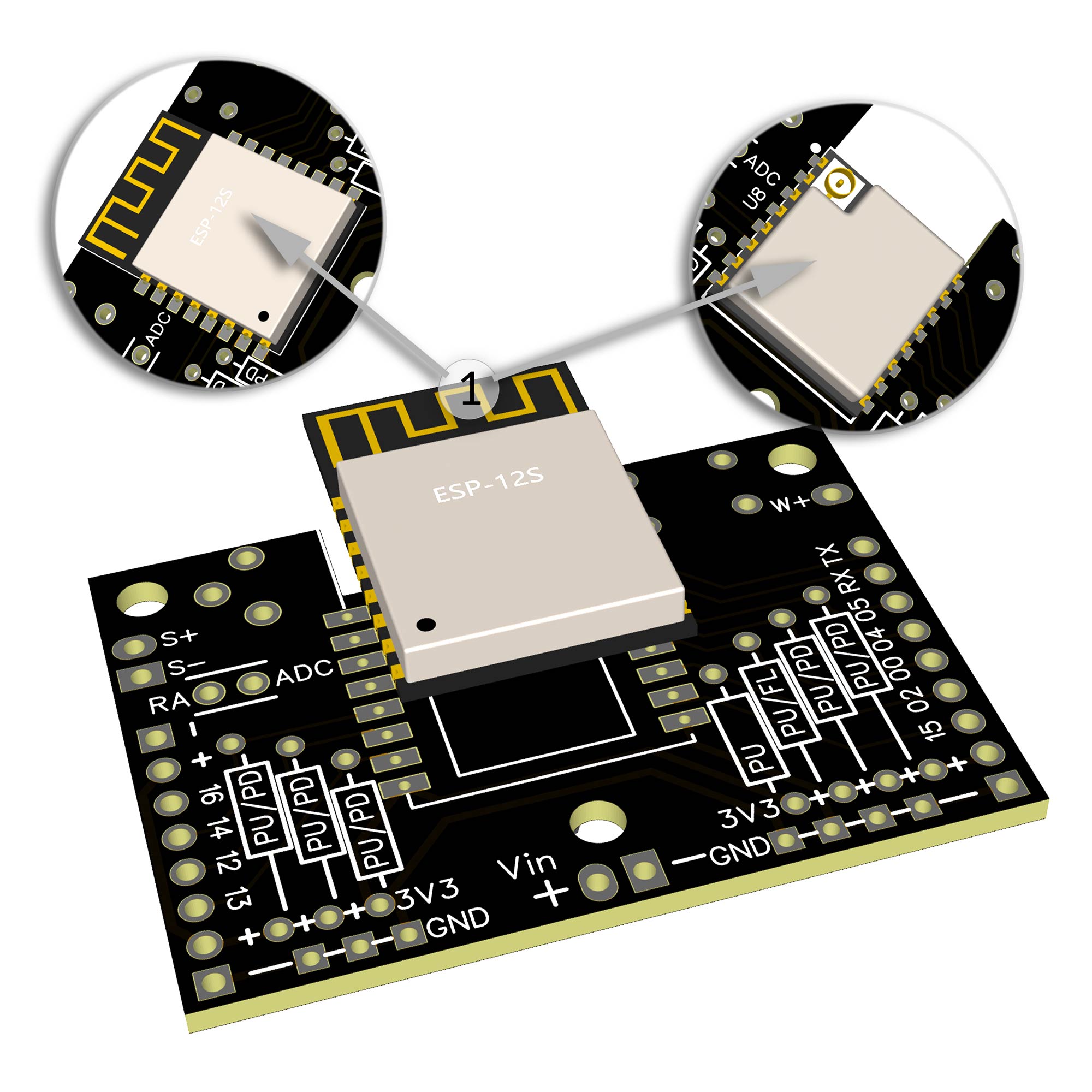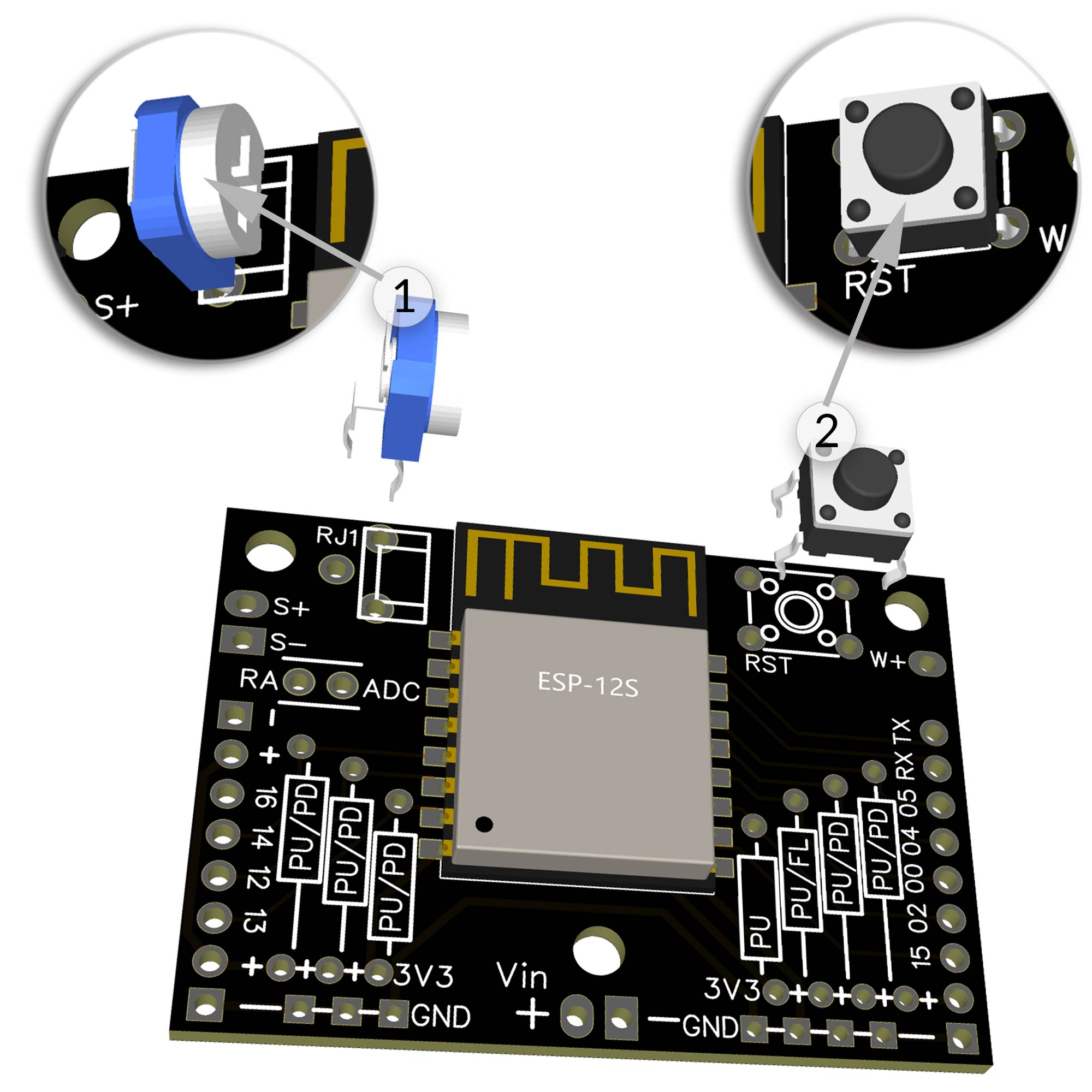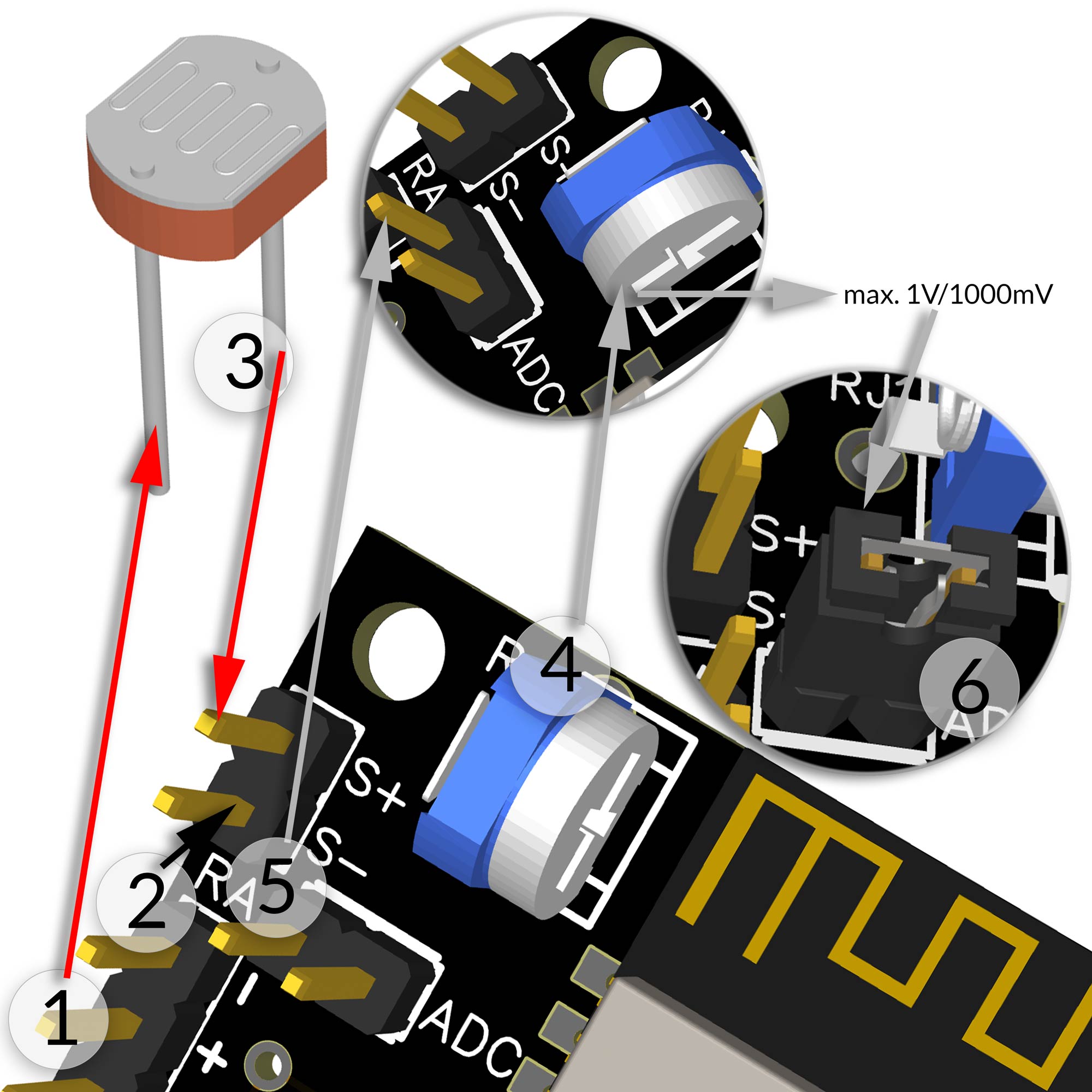
EI-OT ESP8266 Tasmota ESPEasy ESP-07S 5-12V Entwicklerplatine Development Board ADC adj. Pull Down Up Kit Set |
|||||||||||||||||||||||||||||||||||||||||||||||||||||||||||||||||||||||||||||||||||||
EI-OT ESP8266 ESP-07S Development Board Set © ei-ot ® 
EI-OT ESP8266 ESP-07S 5-12V Development Board Set © ei-ot ® 
EI-OT ESP8266 Development Board Dimesnions © ei-ot ® 
EI-OT ESP8266 Development Board Module Assembling © ei-ot ® 
EI-OT ESP8266 Development Board Pin Header Assembling © ei-ot ® 
EI-OT ESP8266 Development Board Voltage Divider Reset Button assembling © ei-ot ® 
EI-OT ESP8266 Development Board 5-12V Power Supplyconnecting © ei-ot ® 
EI-OT ESP8266 Development Board Pull Up Pull Down Resistors © ei-ot ® 
EI-OT ESP8266 Development Board ADC Voltage Divider © ei-ot ® 
|
Unsere EI-OT ESP8266 Entwicklerplatine im Set mit dem ESP8266 ESP-07S Modul ist wie folgt verfügbar
1 Die Tasmota und ESPEasy Firmware ist stets in englischer Sprache und eignet sich um bei Bedarf die individuelle Firmware mittels OTA Update zu installieren, es wird kein USB TTL Konverter benötigt. ESP8266 ESP-07S
Der ESP-12 Modul basiert auf der ESP8266EX MCU und verfügt über einen 32Mbit Flash Speicher, 64Kb Instruction Ram und 96Kb Data Ram. Je nach installierter Firmware können die GPIO's als
EI-OT ESP8266 Entwicklerplatine
Im Vergleich zu typischen ESP8266 Entwicklerplatinen wurde die EI-OT ESP8266 Entwicklerplatine für einen weitreichenden praktischen Einsatz konzipiert. Bereits bei der Spannungsversorgung wird ein TLE42744GSV33 von Infineon verwendet. Diesbezüglich erlaubt das EI-OT ESP8266 Modul Spannungsversorgungen von 5-12V bei bis zu 400mA. Neben der typischen Ausführung der GPIO's auf Stiftleisten (im Abstand von 2,54 mm angeordnet) stehen zusätzlich 3,3V Ausgänge zur Spannungsversorgung von beispielsweise Sensoren bereit. analoger Signaleingang
Neben den digitalen GPIO's verfügt die EI-OT ESP8266 Entwicklerplatine über einen analogen Signaleingang in Kombination mit einem variablen Spannungsteiler. Im Detail können analoge Eingangssignale mittels Potentiometer, individuell auf den ADC Eingang des ESP8266 eingestellt werden. Pull Up & Pull Down Widerstände
Beim Einsatz der ESP8266 GPIO's bedarf es typischerweise einem Pull Up oder Pull Down Widerstand. Die EI-OT ESP8266 Entwicklerplatine verfügt über entsprechende Kontakte um
Firmware
Der Funktionsumfang der EI-OT ESP8266 Entwicklerplatine wurde strikt den typischen und grundlegendem Funktionsprinzip des ESP8266EX angelehnt.
Die ESP8266 Entwicklerplatine
ist bereits auf der Rückseite mit grundlegende SMD Komponenten wie
EI-OT ESP8266 Entwicklerplatine Bausatz Lieferumfang
Neben der Hauptplatine sind im EI-OT ESP8266 Entwicklerplatinen Bausatz folgende Komponenten enthalten:
ESP8266 ESP-07S Entwicklerplatine für 5-12V VCC optimiert für den praktischen Einsatz GPIO und weitere Anschlüsse
Bei der ESP8266 Entwicklerplatine wurde folgende Anschlüsse auf Pins (2,54mm raster) ausgeführt
|
Our EI-OT ESP8266 developer board in set with ESP8266 ESP-07S module is available as follows
1 The Tasmota and ESPEasy firmware is always in English and is suitable for installing the individual firmware using OTA update function, - no USB TTL converter is required - ESP8266 ESP-07S
The ESP-12 Module is based on the ESP8266EX MCU and features 32Mbit Flash memory, 64Kb Instruction Ram and 96Kb Data Ram. Depending on the installed firmware, the GPIO's can be used as
EI-OT ESP8266 Development Board
Compared to typical ESP8266 developer boards, the EI-OT ESP8266 developer board is designed for wide-ranging practical use. A TLE42744GSV33 from Infineon is already used for the power supply. In this regard, the EI-OT ESP8266 module allows power supplies of 5-12V @ up to 400mA. In addition to the typical design of the GPIOs on pin strips (arranged at a distance of 2.54 mm), there are also 3.3V outputs available for the power supply of sensors, for example. analog signal input
In addition to the digital GPIO's, the EI-OT ESP8266 developer board has an analog signal input in combination with a variable voltage divider. In detail, analog input signals can be adjusted individually to the ADC input of the ESP8266 using a potentiometer.
Pull Up & Pull Down Resistors
When using the ESP8266 GPIO's, a pull up or pull down resistor is typically required. The EI-OT ESP8266 developer board has corresponding contacts around
Firmware
The range of functions of the EI-OT ESP8266 developer board was strictly based on the typical and basic functional principle of the ESP8266EX.
The ESP8266 Development Board
is already assembled with SMD components
The EI-OT ESP8266 Development Board Kit scope of delivery
In addition to the main board, the following components are included in the EI-OT ESP8266 developer board kit :
ESP8266 ESP-07S developer board for 5-12V VCC optimized for practical use GPIO and additionally Connections
The ESP8266 developer board has the following connections on pins (2.54mm pitch).
|
|||||||||||||||||||||||||||||||||||||||||||||||||||||||||||||||||||||||||||||||||||
|
|||||||||||||||||||||||||||||||||||||||||||||||||||||||||||||||||||||||||||||||||||||
EI-OT ESP8266 Development Board ESP-07S ESP-07S Module assembling  |
ESP8266 bestücken
Die EI-OT ESP8266 Entwicklerplatine ist bereits mit SMD Komponenten auf der Rückseite bestückt. Zur Inbetriebnahme müssen nachfolgende Komponenten wie in nebenstehender Grafik (zum Vergrößern auf das Bild klicken) bestückt / verlötet werden
Die Bestückung der EI-OT ESP8266 Entwicklerplatine Schritt für Schritt:
|
ESP8266 Assembling
Besides the SMD components on bottom side of PCB, the EI-OT ESP8266 Development Break Out Module requires additional components.
Assembling of the 16 Channel PRO Relays Module Step by Step:
|
EI-OT ESP8266 Dev.-Kit ADC Potentiometer RST Button assembling  |
Poti Taster bestücken
Nachdem das ESP8266 LED Controller Modul mit dem ESP8266 bestückt wurde müssen der Potentiometer und der Reset Taster wie folgt bestückt werden:
|
Poti Button Assembling
After assembling ESP8266 module on EI-OT ESP8266 Break Out Board, Reset Button and ADC Potentiometer must be assembled:
|
EI-OT ESP8266 LED Stripe Controller TO220 assembling  |
Stiftleisten bestücken
Zur besseren Differenzierung umfasst der Lieferumfang des EI-OT ESP8266 Entwicklerkit farbige Pinleisten
|
Pinheader Assembling
For better differentiation, the scope of delivery of the EI-OT ESP8266 developer kit includes colored pin strips
|
ESP8266 Development Board 5-12V Power Supply connection  |
Spannungsversorgung
Die EI-OT ESP8266 Entwicklerplatine verfügt über einen AMS1117 Spannungskonverter und erlaubt Versorgungsspannungen von 5VDC bis 12VDC.
Die Spannungsversorgung der EI-OT ESP8266 Entwicklerplatine erfolgt zentral über Vin 2 -polige, rote Pinleiste.
Beim Anschluss muss stets auf + und - geachtet werden, ein falscher Anschluß führt zu Beschädigung der ESP8266 Entwicklerplatine. |
Power Supply
The EI-OT ESP8266 developer board has an AMS1117 voltage converter and allows supply voltages from 5VDC to 12VDC.
The power supply of the EI-OT ESP8266 developer board is done centrally thru Vin 2-pin, red pinheader.
When connecting, always pay attention to + and -, incorrect connection will damage the ESP8266 developer board. |
|
Pull Up Pull Down Widerstand
Als typische MCU (MikroController Unit) verfügt der ESP8266 über GPIO's (General Purpose Input/Output). Mit einfachen Worten ein Pin / Kontakt der individuell und anwendungsspezifisch genutzt werden kann, beispielsweise als
|
Pull Up Pull Down Widerstand
As a typical MCU (microcontroller unit), the ESP8266 has GPIOs (General Purpose Input/Output). In simple words, a pin / contact that can be used individually and application-specifically, for example as a
|
ESP8266 Development Board Pull Up Pull Down Resistor connection  |
Pull Up anschliessen
Bitte stets auf entsprechenden Abstand zwischen Platine und Widerstand achten um einen Kurzschluss zu vermeiden
Pull Down anschliessen
Bitte stets auf entsprechenden Abstand zwischen Platine und Widerstand achten um einen Kurzschluss zu vermeiden
|
Pull Up connection
Bitte stets auf entsprechenden Abstand zwischen Platine und Widerstand achten um einen Kurzschluss zu vermeiden
Pull Down connection
|
|
ESP8266 ADC Eingang
Der ESP8266 verfügt am GPIO17 über einen analogen Signaleingang. Mittels einem ADC (Analog Digital Converter) werden analoge Spannungswerter auf einen digitalen Wert von 0 bis 1023 umgesetzt.
Der ESP8266 unterstützt dabei maximal 1000mV am ADC Signaleingang. Signalwerte über 1V können zu Beschädigung des ESP8266 führen.
Diesbezüglich verfügt die EI-OT ESP8266 Entwicklerplatine über einen variablen, mittels Potentiometer einstellbaren Spannungsteiler, um den maximalen Signalwert individuell zu begrenzen.
Die Verwendung, Anschluss und Einstellung wird nachfolgend am Beispiel eines einfachen LDR (lichtempfindlichen Widerstand) beschrieben.
Selbstredend bedarf es einem Multimeter zur Messung von Gleichspannung um die Signalspannung entsprechend zu limitieren! |
ESP8266 ADC Input
The ESP8266 has an analog signal input on GPIO17. The GPIO17 has an ADC (Analog Digital Converter), to convert analog voltage values to a digital values from 0 to 1023.
The ESP8266 supports a maximum of 1000mV at the ADC signal input. Signal values above 1V can damage the ESP8266.
In this regard, the EI-OT ESP8266 developer board has a variable voltage divider that can be set using a potentiometer in order to individually limit the maximum signal value.
Typical application, connection and setup is described below, using a simple LDR (Light Dependent Resistor) as an example.
Of course you need a multimeter to measure DC voltage in order to limit the signal voltage accordingly. |
ESP8266 RGBW Module RGB LED and Power Supply connection  |
LDR anschliessen
Vor Beginn stelle sicher dass
Signalspannung einstellen
Vor Beginn stelle sicher dass
|
LDR connection
Before you start, make sure
Signal voltage adjustment
Before you start, make sure
|